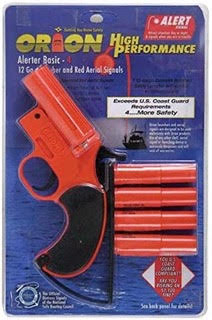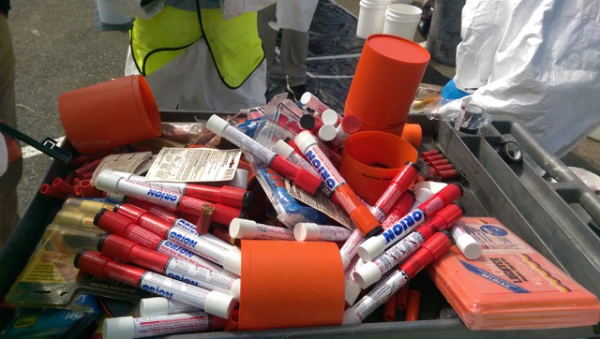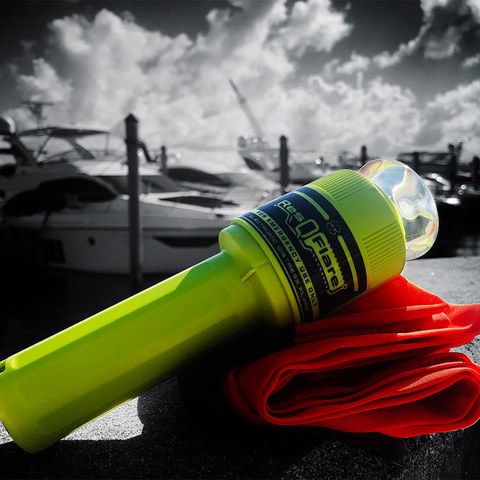 |
Here in the South, many of us pronounce “flowers” as “flares”, which sometimes draws odd looks from our northern neighbors when we tell them we got flares for the wife on Valentine’s day. (My wife loves boats, but even she would have something unpleasant to say if I presented her with a package of flares for that day which seems so important to ladies.)
Be that as it may, if you operate a powerboat anywhere on U.S. waters, you are required by law to have a pack of operational flares or other nighttime signaling devices aboard. And, while most of us probably do have said flares tucked down underneath the towels and life jackets somewhere, there’s a very good chance they are so far out of date that Franklin D. Roosevelt could have used them on the Presidential Yacht.
The Coast Guard or the local marine patrol won’t arrest you for having out-of-date flares aboard (usually, unless you have an attitude) but they’re likely to issue a reminder citation and might even send you back to the dock, especially if you’re out around sundown or after dark. So it’s wise to keep these safety devices updated both legally and for the safety of your family and guests aboard.
Pyrotechnic flares “expire” 42 months after the date of manufacture. If you’ve had yours aboard for more than three summers, it’s time to replace them this spring before you head out. They “expire” but they still work. Some people have been saved by flares almost 10 years out of date. But to be legal, you have to be inside the 42-month window.
A pack of three is one of the least expensive things you’ll buy for a boat, fortunately. A pack of four is about $40.
Incidentally, since flares are sort of an “Oh my God!” device that you are likely to be using in the dark during a period of very high stress, it’s a good idea to take your old flares out in the back yard and practice with them—read the instructions on how to touch them off, and then light them up.
A safety note—these are not toys for the kids. They produce white-hot slag as they burn, and if that stuff falls on a bare foot, it’s a trip to the emergency room. If you use them aboard, hold them out over the water—the drippings can melt fiberglass.

If you just want to get rid of them safely, the Sea Tow Foundation now has a listing of locations where they can be dropped off for safe disposal. See the listing, which includes locations in 13 states, here: Sea Tow Foundation. If there’s not a listing near you, a call to your local fire department will probably do the job.
Don’t throw them in the nearest dumpster—that’s both illegal and a risk to the folks handling the trash.
Alternatively, keep the old flares aboard in the same watertight plastic container where you keep the new ones, because one pack of flares may not be enough to bring help when you really, really need it.
Each flare burns only about 3 minutes, so the typical four-pack is only good for 12 minutes of signaling. Better you should have extras.
You might also opt for aerial flares or a flare gun, which shoot a pyrotechnic flare hundreds of feet into the air. These are more effective than the hand-held flares, but they also have the 42-month expiration on the ammunition. They can also be very dangerous in the hands of inexpert users. They are considered firearms in some states, to give you an inkling, and they fire a 12-gauge round. They’re about $100 including five flares—Orion and others make them.
A new generation of technology allows doing away with disposable (and highly flammable) flares altogether.

There are now Coast Guard-approved strobe emergency flares like ACR’s ResQFlare and Sirius’ Signal-C that operate on a couple of C-cell batteries. The great thing about these is there are no flammables involved, and to operate you simply flip a switch and they begin blinking out an SOS signal. (You may also need an orange distress flag for daytime use—check your state’sregulations—or just carry the flag as an extra precaution, whether you need it or not.)
The battery-powered signaling devices cost about $80, but you can buy one and never have to buy another—just replace the batteries annually. Operational life on a set of batteries is 20 hours according to the companies, over 3 times longer than USCG requirement for maintaining peak fixed intensity.
These things are also great because they’re completely waterproof and require no water-tight storage. In fact, they float, so should the boat sink out from under you, you can take the flair with you into the water (gulp!) and activate it to hopefully direct rescuers to your location.
In the end, flares or night-time signaling devices are one of those things destined to rest forgotten somewhere aboard your boat, and that’s a good thing. But if you ever need them, you’ll be really, really glad the ones you have are up to date and ready to function.
-- Frank Sargeant
Frankmako1@gmail.com